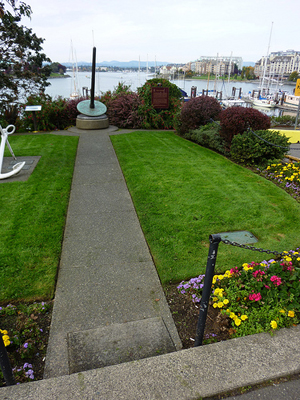Fort Victoria National Historic Site of Canada
Victoria, British Columbia

General view
© Parks Canada Agency / Agence Parcs Canada, Andrew Waldron, 2011.
Address :
Wharf Street at Broughton, Victoria, British Columbia
Recognition Statute:
Historic Sites and Monuments Act (R.S.C., 1985, c. H-4)
Designation Date:
1924-06-04
Dates:
-
1843 to 1843
(Construction)
-
1849 to 1849
(Significant)
-
1846 to 1846
(Significant)
-
1858 to 1858
(Significant)
-
1861 to 1864
(Significant)
Event, Person, Organization:
-
Richard Blanshard
(Person)
-
Hudson’s Bay Company
(Organization)
Other Name(s):
-
Fort Victoria
(Designation Name)
Research Report Number:
2009-SDC-CED-073
Plaque(s)
Existing plaque: mounted on concrete wall in front of steps to Old Victoria Custom House on west side of Wharf St at the very end of Broughton St. Government House, British Columbia
Founded by the Hudson's Bay Company in 1845 Fort Victoria became, after 1846, the headquarters of the Company's trade in British territory west of the Rocky Mountains.
When the Colony of Vancouver Island was formed in 1849 Victoria was the capital and in the fort the first Legislative assembly met. The gold rush of 1858 led to the development of the City of Victoria. The early history of the city and the colony is closely intertwined with that of the fort. The last of the original buildings was demolished in 1862.
Existing plaque: Wharf Street, British Columbia
The mooring rings on the rocks below are the only surviving fragment of Fort Victoria built by the Hudson's Bay Company in 1843. From 1846, when the Oregon boundary was drawn at the 49th parallel, this post served as grand depot and headquarters of the Company's Pacific fur trade. Ships moored here to unload supplies for an extensive network of forts and to take on natural products for export, principally to Alaska, California and Hawaii. In 1849 the first Legislative Assembly of the of the Colony of Vancouver Island met in the fort. The last remaining buildings of Fort Victoria were dismantled in 1864.
Description of Historic Place
Fort Victoria National Historic Site of Canada is located on the southern end of Vancouver Island in Victoria, British Columbia. Now located in downtown Victoria at the intersection of Fort Street and Government Street, the site was established by the Hudson’s Bay Company in 1843. The only extant remains of the 19th-century fort include the palisade, two bastions and three mooring rings located west of the fort site in Victoria Harbour, adjacent to Malahat Building / Old Victoria Custom House National Historic Site of Canada. Official recognition refers to the footprint of Fort Victoria, including the palisade and bastions, as well as three nodes formed by three remaining mooring rings.
Heritage Value
Fort Victoria was designated a National Historic Site of Canada in 1924 because: founded in 1843, Fort Victoria became, after 1846, the grand depot and headquarters of the Hudson’s Bay Company’s trade in British territory west of the Rocky Mountains; in 1849, the first Legislative Assembly of the Colony of Vancouver Island met in the fort.
The heritage value of Fort Victoria lies in its historical associations with the Hudson’s Bay Company (HBC) trade activities and its role as an early political centre in British Columbia. In 1843, the Hudson’s Bay Company established Fort Victoria on the coast of James Bay, in what is now the City of Victoria. The fort was constructed as a result of American encroachment on British territory. Fearing that the United States would assume control over the Oregon Territory and the lands to the north, the British established the fort to lay visual claim to the land. In 1846, the Oregon border was established at the 49th Parallel, and the Victoria post became the grand depot and headquarters of the HBC’s pacific fur trade. Ships moored at Fort Victoria to unload supplies for an extensive network of forts and to take on natural products for export, principally to Alaska, California and Hawaii
In 1849, the first Legislative Assembly of the Colony of Vancouver met at the fort, and the following year the Colony of Vancouver Island was founded under governor Richard Blanshard, with Fort Victoria as its capital. After a brief population boom in 1858 due to the Gold Rush, the fort property was sold, the palisade was torn down and within a few years, the last of the buildings were demolished.
Sources: Historic Sites and Monuments Board of Canada, Plaque Text, 1949, 1972.
Character-Defining Elements
Key elements that contribute to the heritage character of the site include: its location at Victoria Harbour in Victoria, British Columbia; the three extant mooring rings located west of the fort site on Victoria Harbour; the integrity of any surviving or as yet not identified archaeological remains associated with Fort Victoria which may be found within the site in their original placement and extent, including the two bastions and palisade; the viewscapes from the fort site and the mooring rings to Victoria Harbour.